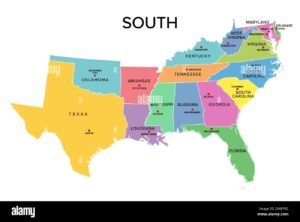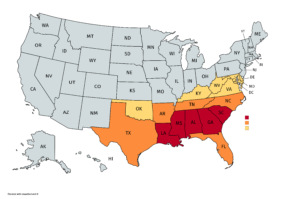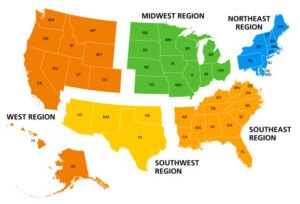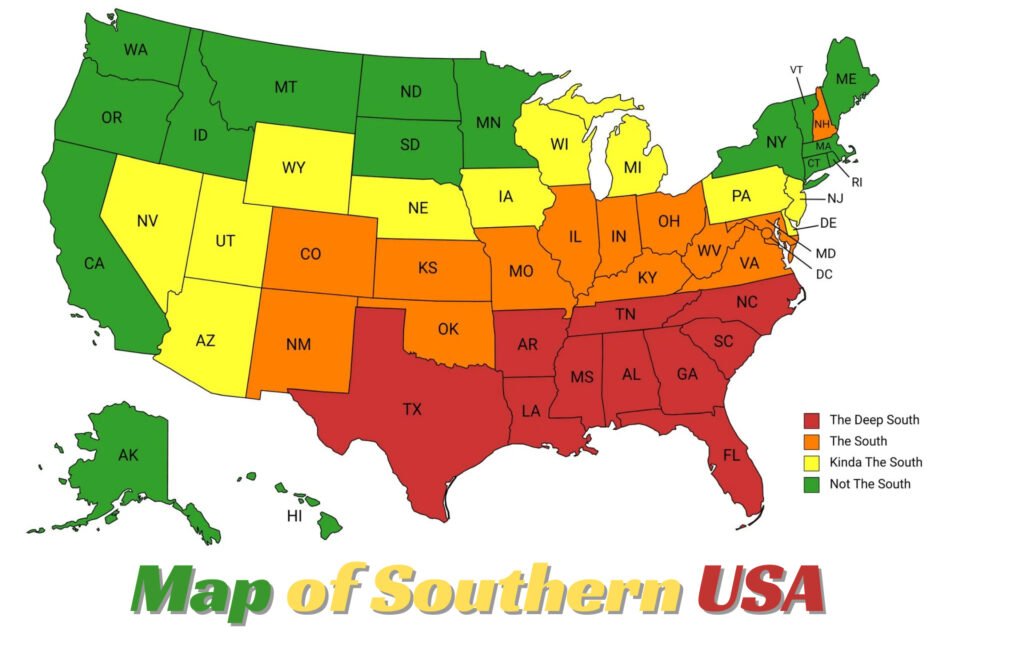The Southern United States, often called “the South,” is rich in history, culture, and geographical diversity. Understanding its layout through maps provides valuable insights into its states, major cities, physical features, and cultural landmarks. This guide delves into the intricacies of the Map of Southern USA, offering a detailed exploration of its geography, historical evolution, and cultural significance.
Table of Contents
ToggleDefining the Southern United States
The definition of the Southern United States varies based on historical, cultural, and geographical perspectives. According to the Census Bureau of USA, the South comprises 16 states, divided into three subregions:
- South Atlantic States: Delaware, Florida, Georgia, Maryland, North Carolina, South Carolina, Virginia, West Virginia, and the District of Columbia.
- East South Central States: Alabama, Kentucky, Mississippi, and Tennessee.
- West South Central States: Arkansas, Louisiana, Oklahoma, and Texas.
This classification encompasses diverse landscapes, climates, and cultures, reflecting the region’s complexity.
Geographical Overview

The Southern United States spans a vast area featuring a variety of geographical features:
- Appalachian Mountains: Extending from Alabama through Georgia, Tennessee, and into the Carolinas and Virginia, these mountains are known for their rich biodiversity and cultural heritage.
- Coastal Plains: Stretching along the Atlantic Ocean and Gulf of Mexico, these lowlands are characterized by fertile soils and significant agricultural activity.
- Mississippi River: Flowing through states like Louisiana and Mississippi, this river has been a crucial waterway for commerce and transportation.
- Gulf of Mexico: Bordering states such as Texas, Louisiana, Mississippi, Alabama, and Florida, the Gulf influences the region’s climate and economy, particularly through industries like fishing and oil extraction.
These features contribute to the Map of Southern USA a unique environmental and economic landscape.
Major Cities and Urban Centers
The South hosts several major cities that serve as cultural and economic hubs:
- Atlanta, Georgia: The main transportation hub and home to numerous multinational corporations.
- Houston, Texas: Known for its energy industry, particularly oil and natural gas.
- Miami, Florida: A cultural melting pot with significant Latin America and the Caribbean influence.
- New Orleans, Louisiana: Famed for its rich musical heritage, particularly jazz, and vibrant Mardi Gras festival.
- Nashville, Tennessee: Dubbed “Music City,” it’s the heart of the country music industry.
These cities exemplify the South’s dynamic growth and cultural diversity.
Historical Evolution of Southern Maps

Map of Southern USA has evolved significantly over the centuries:
- Colonial Era: Early maps were rudimentary, often based on explorers’ accounts and indigenous knowledge.
- 19th Century: With more accurate surveying techniques, maps became more detailed, reflecting the expansion of railroads and settlements.
- Civil War Period: Maps played a crucial role in military strategy, with Union and Confederate forces relying on them for planning.
- Modern Era: High Advancements in technology have led to highly detailed digital maps, incorporating satellite imagery and real-time data.
These developments have enhanced our understanding of the region’s geography and history.
Cultural and Economic Significance
The Map of Southern USA geography has profoundly influenced its culture and economy:
- Agriculture: The fertile soils of the Coastal Plains have supported crops like cotton, tobacco, and rice, shaping the region’s agrarian economy.
- Music: Genres such as blues, jazz, country, and as well as rock ‘n’ roll have roots in the South, reflecting its diverse cultural influences.
- Cuisine: Southern food, known for gumbo, barbecue, and fried chicken, reflects a blend of African, European, and Native American culinary traditions.
These elements highlight the South’s rich cultural tapestry and contributions to the broader American identity.
Modern Mapping and Navigation

In today’s digital age, accessing Map of Southern USA is easier than ever:
- Online Platforms: Services like Google Maps provide interactive maps with features such as street views and real-time traffic updates.
- Geographic Information Systems (GIS): Tools like ArcGIS allow for complex spatial analyses, aiding urban planning and environmental management.
- Mobile Applications: Apps offer offline maps, GPS navigation, and points of interest, enhancing travel and exploration.
These technologies have revolutionized how we interact and understand the region’s geography.
Conclusion
Maps of the Southern United States offer more than just geographical information; they provide a window into the region’s history, culture, and development. The South’s diverse landscapes have shaped its unique identity, from the Appalachian Mountains to the Gulf Coast. Modern mapping technologies continue to enhance our understanding, making the rich tapestry of the Map of Southern USA more accessible than ever before.
FAQs about Map of Southern USA
Which states are considered part of the Southern United States?
The U.S. Census Bureau defines the Southern United States as comprising 16 states: South Carolina, Tennessee, Texas, Alabama, Arkansas, Delaware, Florida, Georgia, Kentucky, Louisiana, Maryland, Mississippi, North Carolina, Oklahoma, Virginia, and West Virginia.
Where can I find detailed maps of the Southern United States?
Detailed maps of the Southern U.S. are available on various platforms. For instance, Maphill offers detailed satellite maps, and east-usa.com provides road and administrative maps of the region.
What are the major geographical features highlighted in maps of the Southern USA?
Map of Southern USA typically highlight significant geographical features such as the Appalachian Mountains, the Mississippi River, the Gulf of Mexico coastline, and the Atlantic Coastal Plain. These features are crucial in the region’s climate, economy, and culture.
How has the mapping of the Southern United States evolved?
Mapping of the Southern U.S. has evolved from early colonial sketches to modern digital cartography. High Advancements in technology have led to more accurate and detailed representations, incorporating satellite imagery and Geographic Information Systems for comprehensive spatial analysis.
Are there interactive maps available to explore the Southern United States?
Yes, interactive maps are widely available. Platforms like Google Maps offer interactive features, including street views, real-time traffic updates, and route planning, enhancing the exploration of the Southern U.S.
What cultural and historical landmarks are commonly featured on maps of the Southern USA?
Maps often highlight cultural and historical landmarks such as the French Quarter in New Orleans, the Alamo in Texas, Civil War battlefields, and the historic districts of Charleston and Savannah. These landmarks are integral to the region’s rich heritage and are popular destinations for visitors.

